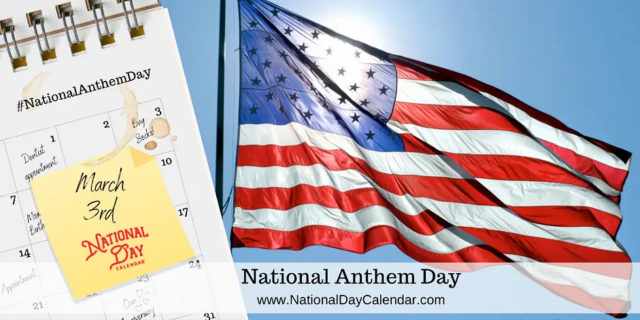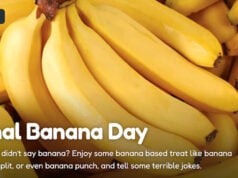
Written by Francis Scott Key, the “Star Spangled Banner” is the national anthem of the United States of America. National Anthem Day commemorates the day our nation adopted “The Star Spangled Banner” as our National Anthem.
The story behind “The Star Spangled Banner” is as moving as the anthem itself.
- Francis Scott Key wrote the poem “Defence of Fort McHenry” while on a mission to make a prisoner exchange for Dr. William Beanes, who had been captured by the British.
- Francis Scott Key was aboard a British ship until the end of the bombardment of Fort McHenry. He agreed to stay aboard the ship as part of the condition of release of Dr. William Beanes and wrote the poem when he realized the next morning that the Americans had won the battle and their flag was still flying.
- Nearly 117 years passed after Key penned “Defence of Fort M’Henry” before it became the national anthem of the United States of America. “Hail Columbia” and “My Country ‘Tis of Thee” held honorary places as patriotic songs. But, the United States didn’t have an officially declared anthem until a congressional resolution, signed by President Herbert Hoover, until “The Star Spangled Banner” became the national anthem of the United States of America on March 3rd, 1931.
- The Melody is Based on an Old English Drinking Song. There’s no arguing that the melody that our anthem is set to is bombastic, emotional, and all-American. But, in truth, it has no basis in American music whatsoever. The melody is actually based on an old English drinking song called To Anacreon in Heav’n. It was the official song of the Anacreontic Society, an 18th century men’s social club in London.
- It Was a Poem Before a Song. Francis Scott Key was a poet, not a musician, so the words he wrote were originally in the form of a poem which was to be titled Defense of Fort McHenry.
- The Original Sheet Music Featured a Spelling Mistake. When sheet music for the Star-Spangled Banner was printed for the first time in 1814, the original printing featured a glaring misspelling. The subtitle of the song was supposed to read “A Patriotic Song,” but it wound up being printed as “A Pariotic Song.” There are about a dozen copies of the original printing left today.
- The Flag was Hidden During World War II. The actual flag that the poem was based on first came to the Smithsonian Museum in the National Mall in 1907. But, after the Japanese attacked Pearl Harbor to kick off World War II, President Roosevelt had the flag and other national treasures moved from the National Mall to Shenandoah National Park in Virginia for safekeeping. They remained there from 1942 to 1944.
- There Were Two Flags Raised at the Battle of Baltimore. The poem mentions that the flag flew “through the perilous fight,” but that’s not entirely true. There were two flags used at the Battle of Baltimore, the massive 30-by-42-foot garrison flag and a smaller 17-by-25-foot storm flag. During the battle, the rain was so heavy that the larger flag (which weighed over 500 pounds when wet) had to be lowered and replaced by the smaller storm flag. In the morning, the storm flag was dropped and the large flag was hoisted.
- The Anthem is Longer than One Verse. Most Americans only know the first verse of the Star-Spangled Banner because that is all we really hear when it’s sung at sporting events. But, the original anthem consisted of four verses, with each one ending in “O’er the land of the free and the home of the brave.” A fifth verse was added in 1861 by poet Oliver Wendell Holmes. His verse included the words “the traitor that dares to defile the flag of her stars,” and it was added to support the Union cause in the Civil War.
- The first public performance of the song occurred in 1814, when Ferdinand Durang, an actor from Baltimore, sang it at a tavern called Captain McCauley’s.
- You can thank the Red Sox and the Cubs when you sing it before a sporting event. The history of the national anthem at sporting events is “murky,” according to ESPN, but many trace its place as a commonplace tradition to the 1918 World Series in Chicago. During the seventh inning stretch, in a show of patriotism in the midst of World War I, the military band at the stadium began playing the national anthem. People spontaneously began to sing along, until the entire stadium was filled with song. The Cubs’ administration was so moved by the moment that they made it a ritual.
- Whitney Houston’s version dominated the Billboard charts…twice. The singer astounded audiences with her rendition of the patriotic song at the 1991 Super Bowl. Her recording of the song peaked at number 20 on Billboard’s Hot 100, where it spent 11 weeks. A decade later, Houston’s version was re-released in the wake of 9/11 and spent another 16 weeks on the chart, peaking at number 6.
- Today’s version of the Anthem is Much Different from the Original. What you hear today when the Star-Spangled Banner is sung is much different than what it sounded like over 200 years ago. Originally, it was designed to be sung by a group of people together, but today it has been converted into a much slower song sung by a soloist and often without any musical accompaniment.
- The Song is Surprisingly Not Easy to Sing. Of all of the songs performed in front of American crowds, you would think that our national anthem would be the easiest. But, the song has stumped even some of our country’s biggest and best singers and artists. Whether it’s forgetting words or failing to reach the song’s epic high note, more singers get it wrong than they do right.
Sources:












